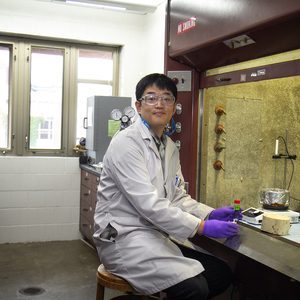Researchers: Lignin could replace biomass processing solvent

SOURCESUNY College of Environmental Science and Forestry
October 2, 2020
BY SUNY College of Environmental Science and Forestry
A research team at SUNY College of Environmental Science and Forestry has a plan to turn waste into a green solvent for biofuel production. Doctors Chang Geun Yoo and Gyu Leem and their graduate students, Yunxuan Wang and Shuya Li, in the departments of chemical engineering and chemistry, have concluded that lignin—a polymer deposited in the cell walls of many plants—has the potential to replace biomass processing solvent and drive down the cost of biofuel. Their findings were selected as the Supplementary Journal Cover in ACS Sustainable Chemistry & Engineering.
The research team focused on lignin found in hardwoods and is looking to find effective solvents that can be used to convert biomass to alternative fuels and chemicals.
Advertisement
"Biomass has great potential for many applications, including alternative fuels, chemicals, and materials," said Yoo. "Our work has identified a cost-effective and renewable approach to using biomass as an alternative source."
Because lignin inhibits biomass conversion and is difficult to remove from plants, the economic feasibility of producing biofuels has been prohibitive thus far, according to Chang. The ESF research team has countered this issue by using lignin that has been removed from the plant material and repurposing it to create an effective lignin extraction solvent, which plays a crucial role in biofuel production.
"This is a perfect example of what we do at ESF," said Yoo. "We look for eco-friendly and sustainable ways to make the best use of every product. The lignin that we're using to create biomass processing solvent would otherwise be discarded as waste. Currently, only 5 percent of the generated lignin from the paper and bioprocessing industry is used as a low-quality energy source. The valorization of this under-utilized lignin can enhance the industrial feasibility of biofuels and biochemicals. In the project, we found a great potential of the lignin component as a future green solvent and catalyst. Especially, the use of p-hydroxybenzoic acid, one of the hardwood lignin components."
Advertisement
The cover art describes the potential closed-loop system by utilizing the hardwood lignin component to synthesize a novel solvent. This solvent effectively converts biomass to maximizing the production of biofuels by removing lignin. The generated lignin can be used for the production of biomass treatment solvent.
Related Stories
SAF Magazine and the Commercial Aviation Alternative Fuels Initiative announced the preliminary agenda for the North American SAF Conference and Expo, being held Sept. 22-24 at the Minneapolis Convention Center in Minneapolis, Minnesota.
Saipem has been awarded an EPC contract by Enilive for the expansion of the company’s biorefinery in Porto Marghera, near Venice. The project will boost total nameplate capacity and enable the production of SAF.
Global digital shipbuilder Incat Crowther announced on June 11 the company has been commissioned by Los Angeles operator Catalina Express to design a new low-emission, renewable diesel-powered passenger ferry.
International Air Transport Association has announced the release of the Sustainable Aviation Fuel (SAF) Matchmaker platform, to facilitate SAF procurement between airlines and SAF producers by matching requests for SAF supply with offers.
Alfanar on June 20 officially opened its new office in London, further reaffirming its continued investment in the U.K. The company is developing Lighthouse Green Fuels, a U.K.-based SAF project that is expected to be complete in 2029.
Upcoming Events










